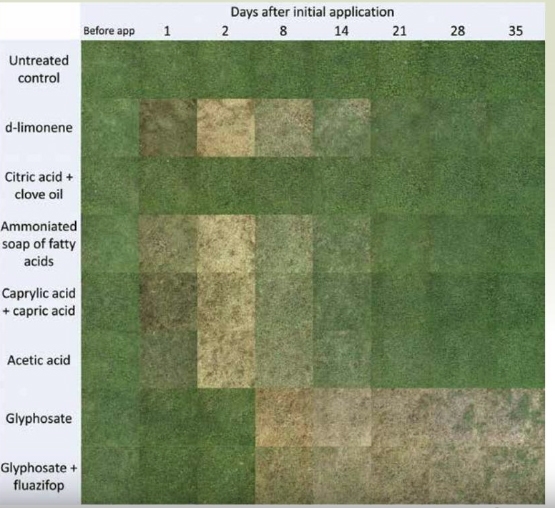UC Cooperative Extension studies organic herbicides for weed control in landscapes
The safety of the weed killer glyphosate, the active ingredient in some well-known Roundup products, has been the subject of attention recently because of lawsuits that connected the chemical to cancer in humans.
Based on extensive scientific research, U.S. regulatory agencies have not banned glyphosate, but the publicity has increased interest in alternatives to the herbicide, which is the most widely used pesticide in the world.
“Everybody is really clamoring for information,” said area integrated pest management advisor Karey Windbiel-Rojas. “Efficacy of organic herbicides is one of the most popular talks I am giving at the moment.”
Windbiel-Rojas and former UC Cooperative Extension environmental horticulture advisor Maggie Reiter launched research projects in 2019 to help fill knowledge gaps on the effectiveness of organic herbicides in urban landscapes – such as lawns, golf courses, parks, cemeteries and school grounds. (Reiter has since taken an extension educator position at the University of Minnesota.)
Organic herbicides are pesticides made of compounds that occur in nature; and synthetic herbicides are compounds developed in laboratories. While both can be more toxic or less toxic to people and the environment, some people prefer using organic methods or chemicals.
On a small scale, a variety of organic solutions to weeds are readily available – such as hand pulling, hoeing and mulching. For larger jobs, professional landscape managers prefer applying an herbicide and look to UC Cooperative Extension scientists to know how well different options will work.
Reiter set up a study on at Ridge Creek Golf Course in Dinuba, and Windbiel-Rojas set up a study on a landscaped area with a mix of grasses and weeds in a parking lot at Sacramento State University.
In the Dinuba experiment, Reiter applied organic herbicides on 25-square-foot plots in four replications. The active ingredients of the organic herbicides included such naturally occurring chemicals as citric acid, clove oil, orange oil, acetic acid (vinegar four times stronger than that found in most home pantries), soaps, and caprylic acid, which comes from coconut and palm kernel oils.
The plots treated with citric acid and clove oil remained as green and lush as the grass in the control areas, which hadn't been treated at all. The areas sprayed with the other organic herbicides showed significant injury two days after treatment. However, 19 days post-treatment the plots treated with caprylic acid and herbicide soaps had completely recovered. The plots treated with orange oil and acetic acid recovered after 28 days.
In the Sacramento State trial, Windbiel-Rojas used some of the same organic compounds, plus others with different natural ingredients, such cinnamon oil, pelargonic acid and ammonium nonanoate, which are drawn from fruit, vegetables and other plant sources.
Many products burned down both grasses and broad-leaf weeds after a few days, however, a couple weeks later, the weeds began to regrow or recover. In addition, some of the organic treatments are more acutely toxic to people than glyphosate.
“While organic, 20% acetic acid is very toxic to the person applying the herbicide,” Windbiel-Rojas said. “It will burn one's skin, hair and eyes so the applicator must wear more personal protective equipment than with some other herbicides. This material is also problematic to use in a public space because any bystanders could be exposed to drift during application.”
The research was published in the February 2020 issue of CAPCA Adviser Magazine. The findings of the research on organic herbicides for turfgrass are preliminary and UC IPM researchers will continue to investigate options.
Windbiel-Rojas will present “Glyphosate Alternatives and Organic Herbicides in Landscapes: Efficacy and Tradeoffs” at the Pesticide Applicators Professional Association Zoom webinar Dec. 2. View the agenda here: https://www.papaseminars.com/uploads/Seminars/11643.pdf. For more information and the registration link, visit https://www.papaseminars.com/seminars.



Posted by Margaret Smith on May 26, 2024 at 6:06 PM